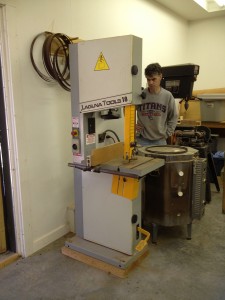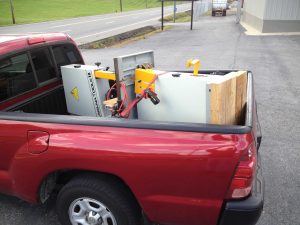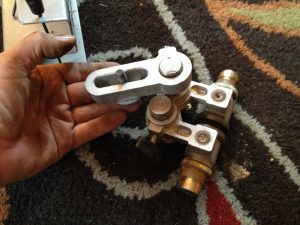We may receive a commission when you use our affiliate links. However, this does not impact our recommendations.
 I don’t generally think of power tools in the same reverential, (perhaps) overly romanticized tones that come to mind when I consider hand tools. I can stare at my grandfather’s 8 oz. Kentucky Bluegrass claw hammer for hours daydreaming about what may have caused the nicks and wear. Or imagine the unknown maker who’s hands wore through the finish on the tote of the #3 Stanley I picked up at a New England flea market years ago.
I don’t generally think of power tools in the same reverential, (perhaps) overly romanticized tones that come to mind when I consider hand tools. I can stare at my grandfather’s 8 oz. Kentucky Bluegrass claw hammer for hours daydreaming about what may have caused the nicks and wear. Or imagine the unknown maker who’s hands wore through the finish on the tote of the #3 Stanley I picked up at a New England flea market years ago.
But I seldom think of power tools in that way. I go through cordless drills like they’re popcorn, tossing one to the trashcan at least yearly without an ounce of lament for anything except the hundred or so bucks I spent on it. I’ve got a couple of biscuit joiners, but I no longer have any idea where I picked them up and haven’t used them in so long that I don’t even recall who made them. If a router motor dies I pick up a new one and dump the old one without even passing thought of ceremony.
Why is this? Is there something inherent in the act of plugging in a tool that predestines disposability? Well. Maybe. Or maybe not.
I recently picked up a new (to me) Laguna 18 inch band saw from the late 90s. When I checked the date on the saw, I realized that, as it was made in 1998, this was exactly the saw I’d wanted to buy new 15 years ago, but a) couldn’t afford and b) didn’t have enough work to justify the purchase of even if I could afford it. So after talking some sense into then young self I started checking the want ads.
After a little poking around I ran across a older Delta/Rockwell 14″ with a riser block already in place. I picked it up in Woodbury, Conn., in 1998 at a workshop that inhabited an old mill on the pristine banks of a small stream. Moving the machine from its perch overlooking quietly gurgling trout water and the old, still functioning water wheel to the dank basement of my rented shop was, from the band saw’s perspective, a definite downgrade. And I’m sure it didn’t appreciate being banged around as single-handedly and sloppily I wrestled it from the bed of my pickup onto hand trucks and through the Bilco doors into my basement.
But with a little help from friends who knew more about machines than I did, I nursed the old Delta back into shape, and then tweaked and tuned it for the last 15 years. I moved it from that shop to another, to another, and so on at least five times. When the engine burned out, I picked up a used one and learned a little more about machines as I replaced it. It’s the band saw that I used to launch a woodworking business, and I learned its quirks along the way. But having roughed out the parts for around 100 chairs last year, the Delta’s the motor is balking again. 
So a couple weeks ago, when I saw the Laguna for sale in my woodworking Guild’s newsletter, I called immediately. Scott Thompson, a friend and Guild member, happened to be over in my shop that day and I asked if he knew anything about the saw. He did. It was the saw of his neighbor and good friend, a solid machine he’s used more than once. He had a key to his pal’s shop, in fact, and could let me in to see it anytime.
I called the saw’s owner again and was told that he bought it from another Guild member, Worth Squire. I called Worth, who told me he’d bought it new and that it served him well but that he upgraded a few years later to get more resaw capacity. He suggested that I upgrade to ceramic band saw guides (which he’d removed when he sold it 10 years ago) but other than that he thought it should be good to go.
I rode out and met Scott the next Saturday. The saw had been sitting unused for a while and there was a little rust to prove it, but it powered right up and the motor sounded strong. The blade tracked well and plowed through a few test scraps. The wheels seemed to be in good shape. There were at least a dozen rusty blades hanging on the wall, so we threw the saw and the lot of the blades into the back of my truck.
I spent half my Sunday dismantling the saw and turning the rust into patina. I still need to pick up a set screw, but the saw is in otherwise good shape and the motor sings. I love the new saw. It is, in fact, the saw that I wanted when I bought the Delta 15 years ago. Still, looking at the Delta squeezed into the corner of the shop that really doesn’t have room for two, I still haven’t been able to post the thing for sale. The motor whimpers, but now I already know how to replace that. And the few cracked pieces from the table’s tilt mechanism could be easily found online.
Maybe, I tell myself, I just need to keep the two saws.
 I often have two people working in my shop and the ability to keep both saws running would really speed things along. As much as I’d like to think that keeping the old Delta is great strategy from a keen business mind geared toward efficiency, I know just as much is sentimentality from all the memories I’ve already got with the saw. I can still tell you where a few of the nicks in the (nearly) zero-clearance insert came from. Perhaps that’s the same thinking that makes me hold onto the extra No. 4s I keep on a high shelf in my shop but never use. Maybe that sentimentality on my part, the soul I project on a tool either power or hand, comes not from whether a tool plugs in or not, but from the history I inherit and then build with the tool.
I often have two people working in my shop and the ability to keep both saws running would really speed things along. As much as I’d like to think that keeping the old Delta is great strategy from a keen business mind geared toward efficiency, I know just as much is sentimentality from all the memories I’ve already got with the saw. I can still tell you where a few of the nicks in the (nearly) zero-clearance insert came from. Perhaps that’s the same thinking that makes me hold onto the extra No. 4s I keep on a high shelf in my shop but never use. Maybe that sentimentality on my part, the soul I project on a tool either power or hand, comes not from whether a tool plugs in or not, but from the history I inherit and then build with the tool.
Having been bought from the friend of a friend and once owned by another friend, I know this new Laguna has the pedigree it needs to coax the same nostalgia I now have for my old Delta saw. Now I’ll just have to put it thought the paces and see if it makes the cut. For now, however, I’m holding on to the old Delta. For perhaps the wrong reasons rather than good sense. It feels like the right reason to keep a tool.
Here are some supplies and tools we find essential in our everyday work around the shop. We may receive a commission from sales referred by our links; however, we have carefully selected these products for their usefulness and quality.









What’s the fun if you can’t take both sides:
The soul of tools is the owner’s soul. The tool is an extnetion of him, and how it allows him to express himself. In that sense power tools are soulful. Car people feel it in their cars, and I feel it when I carve with a chainsaw, shape with a disc sander/jigsaw/ 2×72/ freehand router, etc…
Or:
Tools have a soul in the Doaist sense of having an essential nature. In that regard there is a lot more going on in a power tool, so it has a richer soul, in it’s many parts and natures: electrical, gears, sculture, switches, etc… And each part is inseperable from the soul of those who originally came up with those parts. Mostly for that mater an american sould. Unlike hand tools, whose essentail nature is lost in time and place.
I think hand tools and power tools develop a ‘soul’ after being used many years. I bet that if you had managed to retain one of those cordless (along with a supply of batteries) over a 20 year period, you’d be hard pressed to throw it away if it continued to work. It will have developed character in your mind, as you came to know all of its quirks and the dings that proved its usefulness over the years.
My new tools have no soul. But my 20 year old circular saw is special to me even though I rarely use it now. I can look at it and think of all the previous projects it had a hand in, and smile to myself.
Sounds like that Delta bandsaw, of which I own one myself, has become attached to you. Good for it, and you.
“I go through cordless drills like they’re popcorn.” That reminds me of the way we used to buy a new car about every two years because that’s when they used to start breaking down. Foreign competition was a reason to start building in a little better quality. So what was it that went wrong with those drills? Battery maybe? But the battery is a small part of the drill and is easily replaceable right? Unfortunately not easily and usually not even possible. Isn’t there something very wrong about throwing out a tool because it costs more to replace a battery than the tool costs?
I find the ‘romance’ to very much depend on the tool. With handtools, it’s very easy to distinguish the good from the bad from the ‘shows promise’. The ‘shows promise’ tools are well within our capabilities to make shine by the addition of time and love. Also, there aren’t many hand tools we use that don’t combine contemplative quiet with the contemplative focus required for fine control. So, there is a natural mood there. And…right or wrong we’re not subconsciously afraid of our backsaws.
I find I get the same sensation with power tools, but only in similar circumstances. The biggest counter example is the screaming chop saw. Nothing about that tool is going to inspire affection. But, my 70 year old lathe is a totally different story. It’s quiet (enough), nothing about it makes me edgy, and I can easily (and safely) slip into that zone of manufacturing paradise. It gets as much love and care and concern as any handtool I own.
If you believe that a hand tool has soul then I don’t think a power tool would be any different. The “soul” in my opinion, comes from the objects that we make with our tools, not the tools themselves. I will be the last to argue the importance of any tool. There are certain handtools I own that I will never part with, but I think that all of the tools in my shop are important if I’m using them to work wood.
I upgraded all of the major power tools in my shop a few years ago and sold all of the very well treated older tools I had. The only tool I am sorry I sold is a 14″ Delta bandsaw. My 18″ Laguna is wonderful, but I would love to have two bandsaws on hand. One with a wider blade, and one with a 1/4″ or less to cut curves without changing blades. It went to a good home and was well received, but live and learn.
Gary
Matthew,
Do you plan to write a chair article? Sounds like you may have an interesting system.
Ralph
You’ll know when it is time to let it go. It might be when someone stops by who has more desire to pursue the craft than money to invest it in.
I agree with John’s comments. Your writing was thoughtful and gave me a smile.
Every tool in my shop, corded or not has a little soul in it.
(good article).
Eric
Yep, the decision should be based on space available versus utility. One strategy that may extend it’s use in your shop is to place a fine scrolling blade on it and keep it ready to go for tight radius work, thus saving time by not having to change blades and guide setup on the laguna, thus saving time and $$$. When the value of space it holds exceeds the need for it, then it is time to sell. And fix it, please, with the neccessary parts, as you have the knowledge and experience to do so and the next owner may not. Besides, when it is in perfect (working) shape, you will not hesitate to use it when you need to. Perhaps you can trade it to an aspiring woodworker in exchange for helping you out on a project, thus paying it forward to the next generation.
Not sure about the saws, Matthew, but your writing blew me away. I have a similar relationship with my dad’s ancient Craftsman bandsaw. I’ll never be able to part with that one.